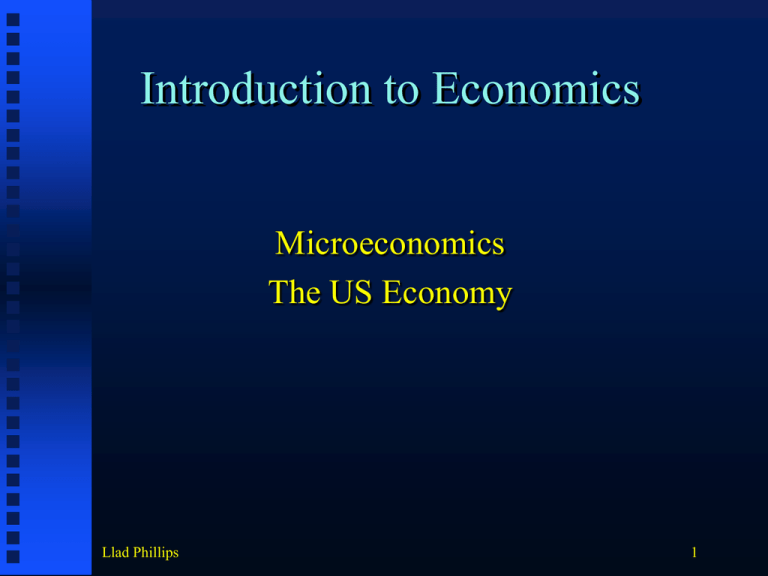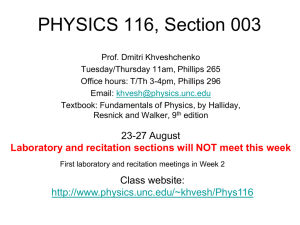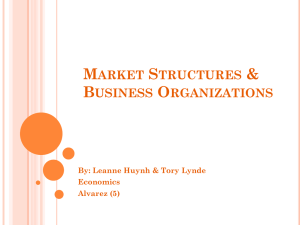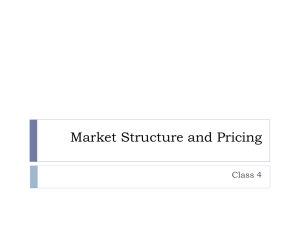Lecture13 - UCSB Economics
advertisement

Introduction to Economics Microeconomics The US Economy Llad Phillips 1 Market Power and Monopoly Is monopoly a good thing or not? How about Microsoft, is this firm good or bad for consumers? Llad Phillips 2 Market Power & Market Structure No market power: competition many producers firms are price takers no excess profit price to consumer = long run average cost Market power: monopoly one producer monopolist is price setter monopolist makes profits at expense of the consumer Llad Phillips 3 The Brief for Competition .... and against monopoly Llad Phillips 4 Outline: Lecture Thirteen Competitive Industries agriculture construction Market Supply in the Short Run The Optimal Plant Size Market Supply in the Long Run Llad Phillips 5 Competitive Markets In the long run, resources will flow to a competitive market if firms are making excess profits new firms will enter the industry if returns to scale are constant, then price will be driven down to long run average total cost if returns to scale first increase and then decrease, price will be driven down to minimum long run average cost Consumers benefit from the efficient, lowest cost use of resources and the lowest price for the product Profits are driven to Zero Llad Excess Phillips 6 Competitive Industries: Agriculture Product cattle corn soybeans wheat dairy products tobacco peanuts rice # of Firms Producing 1176346 789326 441899 352237 162555 136682 18905 12013 source: Census of Agriculture, 1987 Llad Phillips 7 Competitive Industries Product # of Firms Producing contract construction 1951509 apparel 22872 millwork, plywood 7930 household furniture 5606 book publishers 2856 computer/office Equip 2134 knitted textiles 2130 iron/steel foundry Pdt 1231 footwear 479 petroleum refining 331 sources: Census of Manufactures, 1987 Census of Construction Industries, 1987 Llad Phillips 8 Short Run Plant Size of a firm is fixed Llad Phillips 9 Short Run Market Supply: Two Firm Industry MC, AVC MCII MCI AVCI QI Llad Phillips Market Supply AVCII QII QI + QII Quantity 10 Market Supply and Demand in the Short Run MC, Market Price pM Demand QM Llad Phillips Supply Quantity 11 MC, AVC, ATC PM Short Run Market Supply: Two Firm Industry ATCI MCII MCI AVCI ATCII AVCII Market Supply Market Demand Quantity QI QII QI + QII In the short run, both firms are making excess profits. This may motivate them to find the lowest cost size for plant and equipment. Llad Phillips 12 Short Run* World Supply: Copper Country Marginal Cost Zaire 0.49 $ per # Zambia 0.54 $ per # Chile 0.58 $ per # US 0.68 $ per # Peru 0.79 $ per # Canada 0.88 $ per # Metric Tons, 000 560.0 363.0 1356.4 1007.3 397.2 724.4 * Existing Mines Fixed Source: Minerals Yearbook, 1985 Llad Phillips 13 Short Run Supply of World Copper, 1985 . 0.9 Canada 0.8 Peru Marginal Cost, $ per # . 0.7 US 0.6 Chile 0.5 Zaire 0.4 Zambia 0.3 0.2 0.1 0 0 1000 2000 3000 4000 5000 Production, Thousands of Metric Tons . Llad Phillips 14 Long Run What is the optimal plant size? constant returns to scale increasing, then decreasing returns increasing returns to scale Llad Phillips 15 Optimal Size of the Firm: Constant Returns to Scale MC, , ATC pM SMCI SATCI SMCII SATCII LATC, LMC Quantity If market price is above long run marginal cost, the firm will make the same excess profit per unit of output in a large plant as in a small plant. The firm may prefer larger to smaller. As long as firms are making excess profits, other firms will enter the industry, increasing supply, and driving price down to LMC. Llad Phillips 16 Long Run Equilibrium Supply with the Free Entry of Firms: Constant Returns to Scale Market Price Demand Short Run Supply Supply after Entry of Profit Seeking Firms PM PM = LMC = LATC Long Run Supply Quantity Llad Phillips 17 Optimal Size of the Firm: Constant Returns to Scale MC, , ATC SMCI SATCI SMCII SATCII LATC, LMC pM Quantity If market price is above long run marginal cost, the firm will make the same excess profit per unit of output in a large plant as in a small plant. The firm may prefer larger to smaller. As long as firms are making excess profits, other firms will enter the industry, increasing supply, and driving price down to LMC. Llad Phillips 18 Optimal Size of Plant with Variable Returns to Scale LMC LATC Market LATC Price SMCIV SATCI SATCIV SATCII SMCIII pM SATCIII Quantity If market price is above long run average cost, then firms with efficient scale of plant, SATCIII ,will make an excess profit. In the long run other firms in the industry will move to this efficient size plant. As long as there are excess profits to be made, new firms will enter the industry, driving market price down to minimum Llad Phillips 19 long run average total cost, LATC. Long Run Equilibrium Supply with the Free Entry of Firms: Variable Returns to Scale, Deceasing and then Increasing Market Price Demand Short Run Supply Supply after Entry of Profit Seeking Firms PM PM = LMC = Minimum LATC Long Run Supply Quantity Llad Phillips 20 Optimal Size of Plant with Variable Returns to Scale LMC LATC Market LATC Price SMCIV SATCI SATCIV SATCII SMCIII pM SATCIII Quantity If market price is above long run average cost, then firms with efficient scale of plant, SATCIII ,will make an excess profit. In the long run other firms in the industry will move to this efficient size plant. As long as there are excess profits to be made, new firms will enter the industry, driving market price down to minimum Llad Phillips 21 long run average total cost, LATC. Competitive Markets In the long run, resources will flow to a competitive market if firms are making excess profits new firms will enter the industry if returns to scale are constant, then price will be driven down to long run average total cost if returns to scale first increase and then decrease, price will be driven down to minimum long run average cost Consumers benefit from the efficient, lowest cost use of resources and the lowest price for the product Profits are driven to Zero Llad Excess Phillips 22 Natural Monopoly Increasing Returns to Scale optimal larger is better Constant Returns to Scale optimal LAC size of the firm size of the firm: indeterminate = LMC = same at all outputs Increasing then Decreasing Returns to Scale optimal size of the firm: minimum LAC minimum Llad Phillips LAC where LAC = LMC 23 Optimal Size of Plant with Increasing Returns to Scale: Bigger is Better Price LATC SATCI SATCII LATC Quantity LMC Llad Phillips 24 Market Power: Size in 1994 Country Sweden Corporation GDP, $B Sales, $B 169 GM 155 Taiwan 150 Ford 129 Norway 105 Exxon 101 Toyota 95 Hong Kong 91 Wal-Mart 83 ATT 75 Llad Phillips source: World Bank & Fortune 500 25 Market Power: Market Share Product inst. breakfast tennis balls disp. diapers breakfast cereal video game player cameras, film car rental credit cards beer detergent records & tapes Llad Phillips Firms Mkt Shr Carnation, Pillsbury 100/3 Gen Corp, Pepsico 100/4 P&G, Kimberly 99/4 Kellogg, Gen Mills 98/4 Nintendo, Sega 98/2 Kodak, Polaroid Hertz, Avis VISA, MasterCard Anheuser-Busch P&G, Lever Bros Time-Warner, Sony 98/4 95/4 92/3 90/4 86/3 77/4 26 How does a monopolist use power to maximize profits? marginal principle: increase output until marginal revenue = marginal cost Llad Phillips 27 Monopoly Sales Price $10 Price Market Demand A B 0 0 Quantity 10 9 8 7 6 5 4 3 2 1 0 0 1000 2000 3000 4000 5000 6000 7000 8000 9000 10000 Revenue 0 9000 18000 21000 24000 25000 24000 21000 18000 9000 0 Marginal Revenue 9000 9000 3000 3000 1000 -1000 -3000 -3000 -9000 -9000 Quantity Revenue $25,000 A 0 B Llad Phillips Quantity 28 Increasing Returns to Scale and Long Run Total Costs $ Long Run Total Costs Quantity Llad Phillips 29 Maximum Monopoly Profits: Marginal Revenue = Marginal Cost $ LTC R Revenue LTC Quantity $ Excess Profit 0 Llad Phillips Quantity 30 Monopoly Profits with Increasing Returns to Scale Price Market Demand MR Llad Phillips Quantity 31 Monopoly Profits with Increasing Returns to Scale Price LATC Market Demand PM MR LATC Quantity LMC Q Llad Phillips 32 Maximum Monopoly Profits: Marginal Revenue = Marginal Cost $ LTC R Revenue LTC Quantity $ Excess Profit 0 Llad Phillips Quantity 33 The Social Cost of Monopoly: Example, Constant Returns to Scale Competition Monopoly Market Demand Market Demand Consumer Surplus LATC = LMC PM LATC = LMC PM MR QCOMP QMONOP Under monopoly, consumers pay a higher price and consume less Llad Phillips 34 The Social Cost of Monopoly: Example, Constant Returns to Scale Competition Monopoly Market Demand Market Demand Consumer Surplus Dead Weight Loss PM Profit PM LATC = LMC LATC = LMC MR QCOMP QMONOP Under monopoly, some consumer surplus is redistributed to the Llad Phillipsas profit, and some is lost to society 35 monopolist Social Policy If returns to scale are constant regulate make the monopolist charge a price equal to marginal cost • obtain the competitive solution If returns to scale are increasing regulation is not so easy can not set monopolist’s price equal to marginal cost: monopolist will suffer losses • because marginal cost is less than average cost could socialize the industry and the government could subsidize the losses could live with monopoly Llad Phillips 36 Society How can we control it? Regulation, Franchises, Patents Higher Prices Less Goods Excess Profits MONOPOLY POWER Political Influence Strategic Planning Entrepreneurs Llad Phillips How do we get it? 37 Strategic Planning: Brand Names Brand Marlboro Coca-Cola Budweiser Pepsi-Cola Nescafe Kellogg Winstons Pampers Camels Campbell Llad Phillips Company Value, $B Philip Morris 31 Coca-Cola 24 Anheuser-Busch 10 PepsiCo 10 Nestle 9 Kellogg 8 RJR Nabisco 6 Procter & Gamble 6 RJR Nabisco 4 Campbell Soup 4 source: USA Today , 1992 38 Advertising Cost of a Car company Mercedes Nissan Toyota GM Chrysler Ford $ per sale 620 435 381 198 198 123 TV, $M, ‘91 49 267 403 978 335 408 source: Fortune Llad Phillips 39 Strategic Action: Advertising Company Proctor & Gamble Philip Morris General Motors Ford Motor Co. Sears, Roebuck AT&T PepsiCo Chrysler Disney Johnson & Johnson Advertising, ‘94: $B 2.7 2.4 1.9 1.2 1.1 1.1 1.1 1.0 0.9 0.9 source: Advertising Age Llad Phillips 40 Classification of US Industry Sector % Pvt Domestic Output Ag, Forestry & Fishg 1.9 Mining 0.9 Construction 5.3 Manufacturing 21.0 Transport, Commun 8.6 Wholesale Trade 6.8 Retail Trade 10.2 Finance, Insur, Real 18.6 Services: Pers & Bus 26.8 Total 100.0 source: Survey of Current Business Llad Phillips 41 Summary-Vocabulary-Concepts competitive industries short run short run marginal cost optimal plant size long run long run marginal cost constant returns to scale free entry long run equilibrium variable returns to scale excess profits Llad Phillips increasing returns to scale natural monopoly market share marginal revenue monopoly profit social cost of monopoly consumer surplus dead weight loss regulation of monopoly brand names strategic planning 42









